Exploring the Beauty and Significance of Pink Minerals
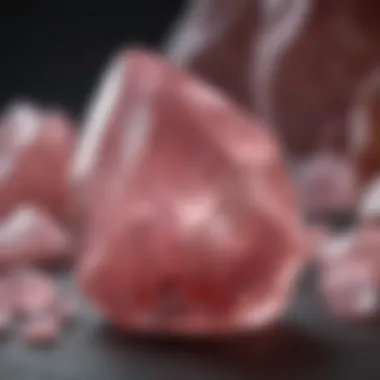
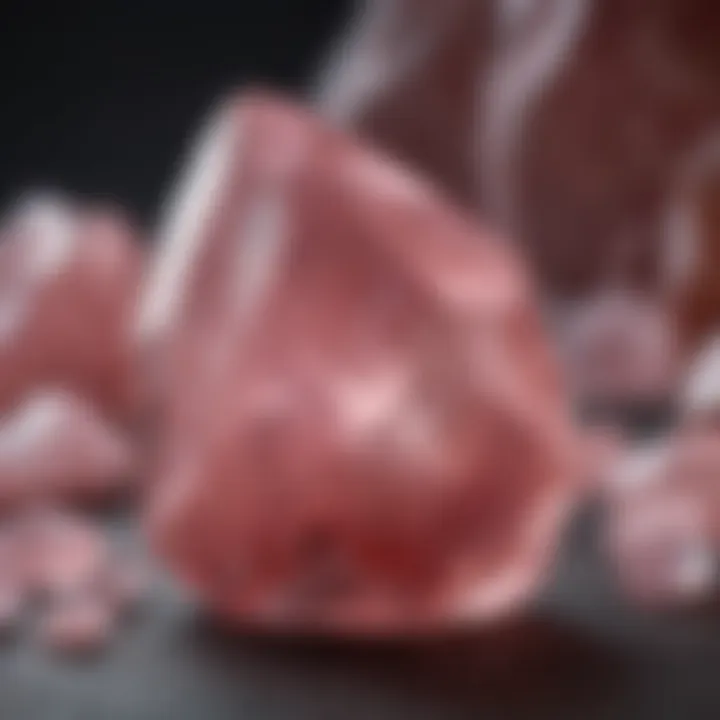
Intro
Pink minerals, while perhaps not the most recognized, hold a mesmerizing charm within the vast spectrum of geological wonders. These minerals, ranging from rose quartz to rhodonite, entice both novice enthusiasts and veteran collectors alike with their striking hues and unique formation processes. Far more than mere decorative objects, pink minerals serve significant purposes in geology, gemology, and even the arts.
This section endeavors to illuminate the various dimensions of pink minerals, exploring their geological characteristics, formation mechanisms, and practical relevance. By dissecting their historical significance and applications, we uncover an engaging narrative that connects the earth beneath our feet to the treasures found within our collections. In doing so, we aim to foster a deeper appreciation amongst collectors of all levels, enhancing their journey within this fascinating field.
Featured Collectible of the Month
Overview
For this month, the spotlight shines on rose quartz, a beloved yet often misunderstood pink mineral. This dreamy stone is not only popular in jewelry, but it also finds its way into the hearts and homes of many due to its purported healing properties and soothing energy. The characteristic soft pink hue stems from trace amounts of titanium, iron, or manganese, giving it an allure that ranges from pale to deeper shades.
Many collectors seek quality pieces, emphasizing not only clarity and color but also the unique inclusions that can tell a story of their own. When meticulously cut and polished, rose quartz showcases its stunning optical phenomena, creating a shimmering effect that is hard to resist.
Historical Significance
Rose quartz has a quartz lineage stretching back thousands of years, used by various civilizations in ancient times. The Egyptians carved it into talismans, believing it offered protection and safeguarded beauty. Across continents, it was revered in ancient Greece, where it symbolized love and beauty, serving as a gift among lovers to symbolize affection.
In the modern era, this mineral continues to hold sentimental value, often associated with heart healing and emotional balance, reinforcing its lasting legacy. As you sift through earthy treasures in pursuit of collectible pink minerals, understanding their history can elevate their significance, transforming mere stones into storytellers of ancient times.
Identification Techniques
Visual Characteristics
Identifying pink minerals might seem daunting at first, but the journey can be made smoother with a few visual cues. Here are essential characteristics guiding your identification process:
- Color: Varying from light to deep pink. The intensity often indicates purity and quality.
- Transparency: Rose quartz is usually translucent to opaque, with variations offering different depths of character.
- Inclusions: Look for unique formations within the crystal structure, offering tales of their geological past.
- Luster: Generally, these minerals exhibit a vitreous luster; under light, they can appear almost ethereal.
Resources for Identification
When it comes to identifying and learning about pink minerals, several resources stand out as invaluable assets:
- Wikipedia provides an exhaustive listing of minerals with description and properties.
- Britannica offers depth in geological context which is beneficial for newcomers.
- Joining Reddit, specifically the rocks and minerals community, can yield practical insights from fellow mineral enthusiasts.
- Utilize social media platforms like Facebook to connect with dedicated groups focusing on mineral collections and identification techniques.
Pink minerals are not just rocks; they are a portal to understanding our planet's past and present. Their vibrant colors can evoke emotional responses, embodying beauty and character while serving educational purposes.
Prolusion to Pink Minerals
The realm of pink minerals is a vibrant and multifaceted dimension of geology that captures both scientific interest and aesthetic appeal. These unique minerals are not just mere geological formations; they serve as a bridge between natural beauty and the complexities of Earth’s processes. For those involved in geology, gemology, or even art, understanding the attributes of pink minerals can open up a treasure trove of knowledge and appreciation.
Pink minerals are often sought after for their striking hues and unique formations. But their significance transcends mere appearance—each type carries a story of its origin and formation. As we examine the importance of pink minerals, we unearth insights into geological processes, chemical compositions, and even market trends.
A key benefit of studying these minerals is recognizing their durability and versatility. From jewelry to industrial applications, pink minerals, such as rose quartz and pink tourmaline, are integral to various fields. Moreover, they often act as indicators of underlying geological activity, offering clues to the history of the Earth itself.
In exploring pink minerals, one must consider not just their beauty but also their cultural significance throughout history. Various civilizations have revered certain pink stones, attributing them with powers of healing and protection. This amalgamation of science, history, and art makes it crucial to engage in a deeper understanding of what defines pink minerals.
"Pink minerals embody the intersection of nature’s artistry and the Earth’s geological narrative."
Overall, delving into the world of pink minerals enriches our comprehension of geology, informs collectors of best practices, and enhances the appreciation for the subtle nuances that these beautiful yet powerful entities offer.
What Defines Pink Minerals?
When discussing what truly defines pink minerals, one must first recognize the primary factor: color. The pink hue in minerals arises from a variety of sources, including trace elements and specific crystal structures. For instance, the inclusion of manganese can impart a delicate pink shade to minerals like rhodonite, while variations in iron content create different tones in minerals such as pink tourmaline.
Additionally, there are several key factors that characterize pink minerals:
- Origin of Color: The color can be a result of chemical impurities, such as chromium in pink sapphires. Understanding this can help in identifying and valuing these minerals.
- Morphology: The shape and structure of pink minerals are also essential elements. Each type has distinctive formations, whether it's the smooth spherical shapes of rose quartz or the layered structure of rhodonite.
- Transparency and Luster: These properties range from transparent to opaque and have significant implications for how these minerals are valued in markets.
- Geological Context: The environments where pink minerals form, such as pegmatites or metamorphic rocks, provide context for their existence and rarity.
In playing a vital role in geology, art, and even psychology, pink minerals serve as a potent reminder of the Earth’s creativity and the interconnectedness of nature. Each pink stone not only holds aesthetic value but echoes stories of the geological forces that shaped it over millennia.
Formation and Composition
Understanding the formation and composition of pink minerals is paramount when exploring their unique characteristics and significance. The various geological processes leading to the creation of these striking minerals contribute not only to their aesthetic appeal but also to their value in geological study and gemology. The composition of these minerals—ranging from trace elements to crystalline structures—plays a crucial role in determining their physical properties and how they can be utilized across different fields.
Geological Processes Involved
The journey of pink minerals begins deep within the Earth where various geological forces operate over thousands to millions of years. Igneous, metamorphic, and sedimentary processes contribute significantly to the formation of these minerals. For example, pink tourmaline forms primarily in granitic pegmatites, where it crystallizes from cooling magma. Similarly, rose quartz emerges from the slow crystallization of silica-rich liquid in granite formations.
Several key geological processes influence the color and quality of the pink minerals:
- Magma Cooling: The rate at which magma cools influences crystal growth; rapid cooling can hinder growth, leading to smaller, less desirable crystals.
- Metamorphic Heat: As rocks undergo metamorphosis due to heat and pressure, existing minerals can be altered in color and structure. Rhodonite, for instance, is believed to form under specific metamorphic conditions, often resulting in its characteristic rosy hue.
- Weathering and Erosion: Even after their formation, pink minerals can be shaped by weathering processes, which enhance their surface features and accessibility.
"The blending of geological elements gives rise to a rich tapestry of minerals that tell the story of Earth’s evolution."
These intricate geological processes ensure that no two formations of pink minerals are entirely alike, contributing to their desirability among collectors and jewelers alike.
Chemical Composition and Varieties
The chemical composition of pink minerals is just as varied and complex as their geological formation. Each type of mineral has a unique chemical structure that dictates its properties, conformation, and how it interacts with light, giving rise to the mineral's color. For instance, pink quartz contains trace amounts of titanium or manganese, which can create its light rosy tint.
Some notable varieties include:

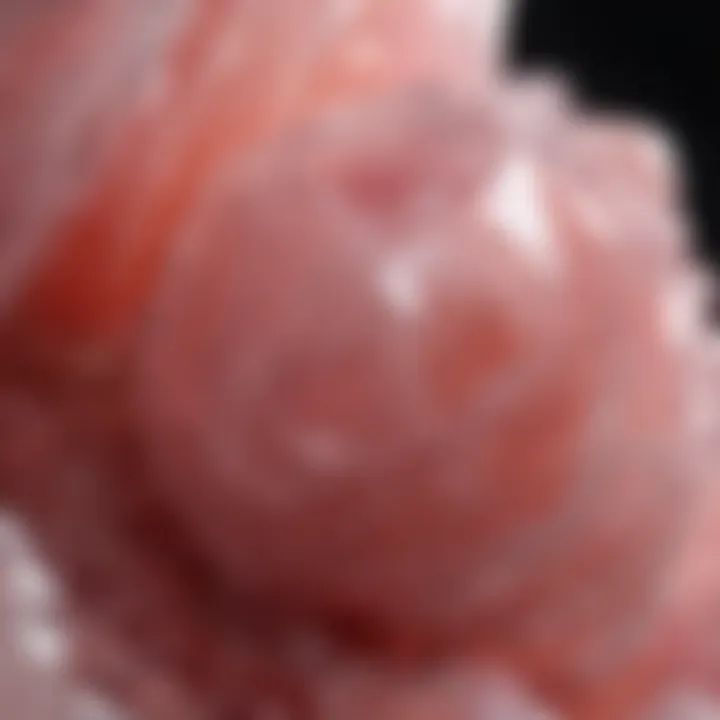
- Rose Quartz: Composed primarily of silicon dioxide, this mineral's pink color legend has been attributed to microscopic inclusions or other trace minerals.
- Pink Tourmaline: A complex boron silicate, it showcases a range of pink shades, influenced by the presence of manganese. Its diverse color spectrum can leave collectors enamored.
- Rhodonite: Often containing manganese, this silicate mineral has a distinct pink color, sometimes with black veining from manganese oxide. Granular and striking, rhodonite is another sought-after specimen.
- Pink Sapphire: A variety of corundum, its vibrant hues are due to the presence of chromium. The more intense the pink, the higher its perceived value in the gem market.
In summary, the formation and composition of pink minerals are intertwined with the Earth’s geological history. Each mineral embodies specific qualities—both in chemical structure and appearance—that influence their value, popularity, and applications.
Notable Pink Minerals
Delving into the world of pink minerals reveals not only their striking beauty but also their significance in various domains. Each notable pink mineral carries its own story, a blend of geological marvel and cultural heritage. Understanding these stones enhances our appreciation for them, especially for collectors who seek more than just an aesthetic. The following sections explore key pink minerals, highlighting their unique characteristics and uses.
Rose Quartz
Rose Quartz is perhaps the most iconic of all pink minerals. Known for its soft, captivating hue, which can range from pale pink to deeper shades, this mineral is composed of silicon dioxide. What distinguishes rose quartz from other stones is its translucent glow, often reminiscent of skin under candlelight. It’s formed under conditions of high pressure and heat, typically found in granitic rocks.
Beyond its physical properties, rose quartz holds a significant place in crystal healing practices. It’s often associated with love and emotional healing, making it a popular choice for jewelry and ornamental objects. Its history also intertwines with various ancient cultures, who believed it to bring peace and emotional balance. Collectors find value not just in its allure, but also in its historical context and varied applications in both art and jewelry.
Pink Tourmaline
Moving on to Pink Tourmaline, this mineral oozes versatility. Each stone seems to tell a tale, with hues varying from light blush to rich raspberry. What’s fascinating about this mineral is its pyroelectric and piezoelectric properties, which means it can generate an electrical charge when heated or pressured. Found in igneous and metamorphic rocks, pink tourmaline forms under unique conditions, requiring boron to create its beautiful colors.
Notably, pink tourmaline is also prized in the world of gemstones due to its durability and brilliance, making it a favorite for exquisite piece of jewelry. Additionally, it’s seen as a protective stone, reputed to foster compassion and calmness. For collectors, finding the right specimen with unique color zoning can be a rewarding experience, blending geological rarity and aesthetic charm.
Rhodonite
Rhodonite stands out for its striking pink color, often intermingled with black manganese oxides. It typically forms in metamorphic environments and is notably found in polar regions. This mineral is named after the Greek word “rhodon,” meaning rose, which beautifully reflects its color.
Beyond aesthetics, rhodonite has notable healing properties, believed to aid emotional healing and stress relief. Additionally, it’s sometimes used in sculptural forms, giving collectors and artisans a dual purpose. Those who seek this pink mineral are often drawn to its unique appearance, with each piece being a one-off masterpiece of natural artistry. Rhodonite’s combination of beauty and function makes it a sought-after mineral in both collecting and crafting.
Pink Sapphire
The Pink Sapphire is surely among the elite in the gem world, renowned for its hardness and brilliance. As a variety of corundum, its color results from trace amounts of chromium, which creates vivid shades ranging from pale to deep pinks. Found in metamorphic rocks, these gems are generally sourced from regions such as Myanmar, Sri Lanka, and Thailand.
Its allure isn't merely due to its physical properties. Pink sapphire is often associated with nobility, love, and integrity. The rarity of high-quality stones can drive collectors to seek them out at auctions, appreciating their value not only as gemstones but also as symbols of devotion. When considering authenticity, the differences between natural and lab-created stones also play a role in the collecting community, adding layers of complexity to the pursuit.
"Each mineral tells a story, from its formation to its cultural significance. Understanding these narratives enriches the experience for every collector."
Geographic Distribution
The study of pink minerals, while often centered on their physical properties and aesthetics, cannot ignore their geographic distribution. Understanding where these minerals naturally occur is essential for collectors and geologists alike. The distribution of pink minerals can influence their availability for collection, their value in the market, and even their cultural significance in various regions.
Knowledge of geographic distribution allows enthusiasts to appreciate the diversity and uniqueness of pink minerals. Some locations are renowned for specific varieties, which can raise interest among collectors. It's also a way to delve into the interplay of geology and human activity, as mining operations and exploration often arise from a region's mineral wealth. Knowing where to find these minerals can lead to remarkable discoveries, potentially sparking a deeper interest.
Major Locations of Pink Mineral Deposits
Pink minerals can be found in a variety of settings across the globe. Here are some specific areas noted for their pink mineral deposits:
- Brazil: Renowned for producing high-quality rose quartz and pink tourmaline, Brazilian deposits are often sought after by gem traders and collectors. The vibrancy of these stones is unparalleled, contributing to their popularity.
- Maine, USA: This state is famous for its tourmaline rich pegmatites. Particularly, the pink variety is highly valued, and collectors may find striking examples in this region.
- Madagascar: Not just known for its biodiversity, Madagascar has notable deposits of pink sapphire. The local geology contributes to the unique coloration found in this mineral.
- Pakistan: The Himalayan region of Pakistan is home to exquisite pink kunzite, often featured in high-end jewelry.
- Afghanistan: This region is noteworthy for its pink tourmaline, where miners face many challenges to extract beautiful and rare specimens.
"The earth speaks in colors, and the pink minerals whisper secrets of their origins and journeys."
Collecting minerals can greatly depend on these locations. The geological processes in these areas shape not only the minerals themselves but also dictate their accessibility. Certain regions might be off-limits or require special permissions for collection, adding to the allure and challenge of hunting for pink minerals. Collectors should be mindful of local laws and environmental considerations when pursuing these natural treasures.
The geographic distribution of pink minerals is a fascinating blend of nature's artistry and the very geology of our planet. By appreciating their origins, collectors can cultivate a deeper connection to these stunning specimens.
Physical Properties and Identification
The examination of pink minerals’ physical properties and identification methods plays a crucial role in understanding these unique geological specimens. For those in the collecting community, recognizing the nuances in appearance, texture, and structural integrity can mean the difference between acquiring a genuinely valuable piece or a mere imitation. Identifying minerals involves not just a keen eye but also a comprehensive grasp of their characteristic features. This understanding enhances one’s appreciation of the collection while also ensuring its integrity, hence demanding a deeper dive into this desirable subject.
Color Variations and Their Causes
Pink minerals can express a fascinating palette of colors, each variation telling its own story. While many people recognize pink simply as a gentle blush of hues, there's much more beneath the surface. Natural pink coloration typically results from the presence of trace elements, such as manganese or titanium. For example, the varying shades of rose quartz range from delicate pastel pink to nearly opaque, rich hues, influenced by iron and the arrangement of microscopic inclusions.
Several factors contribute to these variations:
- Chemical Composition: Different impurities lead to distinct colors.
- Lighting Conditions: The surrounding light can dramatically alter how a mineral appears.
- Crystal Structure: The arrangement at the atomic level affects how light is absorbed and refracted; thus, it can change perceived color.
Diagnostic Features
Identifying pink minerals isn’t solely about color. Diagnostic characteristics such as hardness, luster, and cleavage play a significant role.
- Hardness: Using the Mohs scale, collectors can determine how easily a mineral can be scratched. For example, pink tourmaline is significantly harder than rhodonite.
- Luster: Observing whether a mineral is vitreous, pearly, or dull can provide quick insights into its identity; pink sapphire typically shows a glassy luster.
- Cleavage: The way a mineral breaks can be telling. Some, like pink halite, have perfect cleavage, while others do not.
Understanding these features not only aids in identification but also helps in ensuring that collectors are influenced less by aesthetic allure and more by mineralogical authenticity.
Tools for Identification
To put theory into practice, various tools are essential in the identification process. These tools enhance the collector’s capability to distinguish gems accurately. Here are some widely used tools:
- Hand Lens or Loupe: Magnification helps reveal minute details invisible to the naked eye.
- Hematite Streak Plate: For testing streak color, a simple yet effective approach to gather information.
- Acid test: A few drops of acid can quickly determine calcite; effervescence confirms its presence.
- Specific Gravity Scale: Measures density, helping distinguish between similar-looking minerals.
"A good collector is only as sharp as the tools at their disposal; the right equipment can dismantle doubts and build knowledge."
Understanding and utilizing these tools enables enthusiasts not only to identify but also to appreciate the intricate details of pink minerals. In essence, collectors equipped with knowledge and reliable identification methods can distinguish between the run-of-the-mill and the remarkable, enriching their collections and understanding.
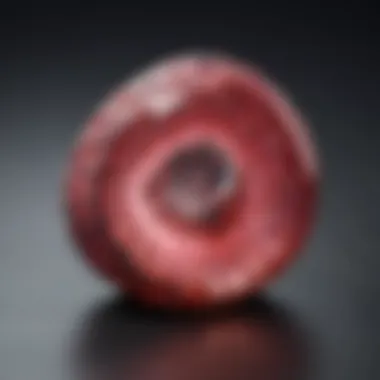
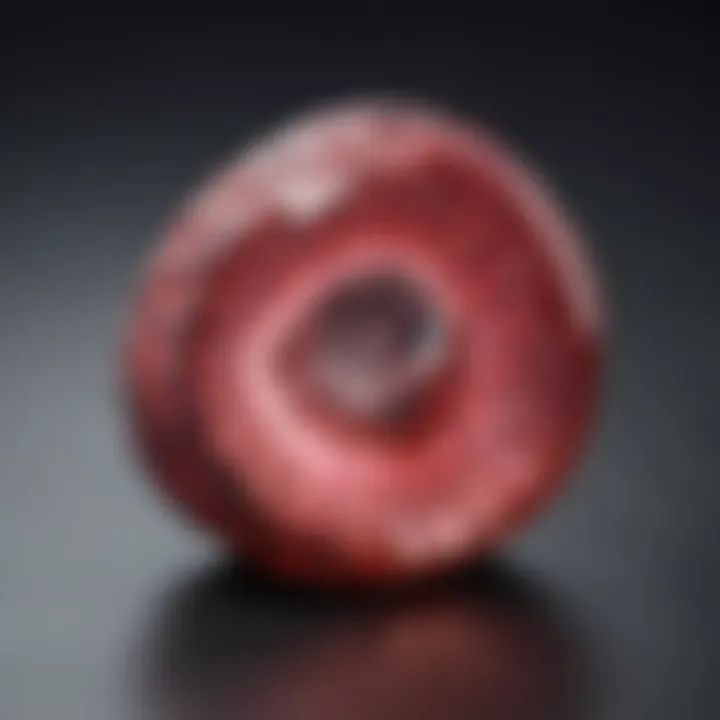
Cultural and Historical Significance
The realm of pink minerals is not merely confined to their physical attributes and geological processes. Their cultural and historical significance is also profound and multifaceted. From ancient civilizations to modern gem enthusiasts, these minerals have been imbued with meanings that transcend their mere aesthetic appeal. Understanding this context can enliven our appreciation and enhance the journey of rock and fossil collectors.
Symbolism and Legacies
Pink minerals, like rose quartz and pink tourmaline, have woven themselves into the tapestry of mythology, spirituality, and artistic expression. The soft hues radiate warmth and compassion, making them symbols of love and emotional healing in various cultures.
- Rose Quartz: Often dubbed the “stone of unconditional love,” rose quartz has held places of honor in ancient societies. In some parts of the world, it was believed that this mineral could attract love and mend broken relationships. Its soft pink shade has been linked to the heart chakra, playing a crucial role in emotional healing and balance.
- Pink Tourmaline: This mineral has a history steeped in the belief of protection and empowerment. Many native cultures viewed it as a guardian stone, bringing courage and a sense of safety to its bearer. It was also treasured for its supposed ability to foster emotional resilience.
- Cultural Artifacts: Beyond their symbolic meanings, these minerals have found their way into cultural artifacts. Artisans have used them for centuries to create beautiful jewelry, amulets, and carvings. The appeal of their color often dictated their use in royal regalia and ceremonial objects.
"Pink minerals remind us of the delicate balance between beauty and emotion, carrying stories of human experience throughout history."
In terms of legacies:
- Art Movements: Pink minerals have inspired countless artists. Throughout history, the gentle tones of pink have been synonymous with romanticism and softness in art, translating into canvases and sculptures that evoke a sense of tranquility and love.
- Modern Usage: Today, the appreciation extends into wellness practices. Gem therapy has gained traction, where practitioners use pink minerals to promote healing and emotional balance.
- Community Connection: Collecting pink minerals can create a unique bond among enthusiasts. Sharing stories about specific pieces can serve as a bridge between cultures and generations. Collectors often find themselves not just acquiring stones, but nurturing a legacy filled with personal journeys and collective histories.
In summary, the symbolism and legacies of pink minerals provide a rich backdrop that enhances their allure. For collectors, these aspects underscore the minerals' significance, fostering a deeper connection to the rocks that might otherwise seem merely beautiful to the casual observer.
Practical Applications
The realm of pink minerals is not just a feast for the eyes; their practical applications span multiple industries, intertwining aesthetics with functionality. Understanding these applications is crucial for enthusiasts and collectors since it enhances appreciation and provides insights into how pink minerals can be utilized beyond mere decoration. Whether in jewelry, technology, or industry, these minerals play a significant role in modern society, offering various benefits that are worthy of exploration.
In Jewelry and Ornamentation
Pink minerals have carved a niche in the world of jewelry design, thanks to their captivating hues and unique properties. Among the standout pieces, rose quartz and pink tourmaline are particularly cherished not just for their beauty, but also for their meanings.
- Rose Quartz: Often labeled the "love stone," this mineral is sought after for its gentle pink essence and healing properties. It's commonly cut into cabochons and beads, creating pieces that resonate emotionally with wearers.
- Pink Tourmaline: This mineral is favorite among gemologists due to its wide range of pink shades. Its structural integrity allows for intricate cuts that showcase its brilliance. Many artisans use it in bespoke jewelry, blending it with gold or silver to enhance its allure.
Furthermore, pink sapphires are making strides not only in engagement rings but also in fine jewelry collections. Their durability and rarity make them a desirable choice for those looking to combine wearability with elegance. Collectors often focus on these minerals' unique qualities—finding a fine specimen can be akin to striking gold in the world of minerals.
Whether crafting a one-of-a-kind piece or indulging in ready-made jewelry, understanding the characteristics of these pink stones elevates not just the aesthetic value but also the cultural significance of jewelry.
Industrial Uses
The practical applications of pink minerals extend far beyond aesthetics. Their properties lend themselves to numerous industrial uses that often go unnoticed by the average enthusiast. For instance, pink quartz isn't just a pretty rock; it’s utilized in various manufacturing processes.
- Technology Manufacturing: Fine-grained pink quartz can be ground down into powders and used as an abrasive in the production of surfaces, glass, and other materials. Its hardness and durability make it an excellent choice for refining processes.
- Cosmetics and Skincare: Powdered rose quartz finds its way into numerous beauty products. Its smooth texture and purported healing properties are reasons it's seen in facial rollers and skincare lines, working as a skin soothing mineral.
- Construction and Decoration: Pink marble, a derivative of certain pink minerals, features in both architecture and interior design. Its elegance adds a touch of warmth to spaces, making it sought after in upscale homes and commercial buildings.
In the end, understanding these applications helps collectors not only appreciate these minerals in a new light but also recognize their value across various fields.
"The heart of a mineral lies in its story and its function beyond what meets the eye, revealing how truly interwoven they are with our daily lives."
The acknowledgment of pink minerals isn’t merely about their visual appeal but embracing the expansive tapestry of their applications that influence human experience.
Care and Preservation of Pink Minerals
Taking good care of pink minerals is paramount, not just for their aesthetic appeal but also for their longevity. These beautiful geological specimens can undergo wear and tear if they are not handled properly. The importance of preservation can't be overstated, especially for collectors who often treat these minerals with a sense of reverence. They are more than just pretty rocks; they can hold significant value in both monetary and sentimental terms.
When you think about pink minerals, consider their delicate nature. Many of them, like pink tourmaline or rose quartz, can scratch or chip easily. If you're aiming to maintain your collection's value, it’s crucial to implement effective care and preservation techniques. This not only protects your investment but also enhances the enjoyment you get from displaying or using these minerals.
Moreover, proper maintenance can aid in the practical functionality of the minerals, particularly those used in jewelry. Properly cared-for pink sapphires, for instance, can retain their brilliance and luster, making them eye-catching elements in any collection or jewelry piece.
Thus, understanding the cleaning methods, storage solutions, and general handling tips is vital to every collector. Ignoring these factors could lead to irreversible damage, resulting in disappointment down the line.
Cleaning and Maintenance Techniques
To keep pink minerals looking their best, a variety of cleaning methods exist. Here are a few techniques that will help:
- Soft Cloths: Use a soft, lint-free cloth for gentle buffing. This method is effective when you want to remove dust and fingerprints without harming the surface.
- Mild Soap and Water: For routine cleaning, a solution of mild soap and warm water works wonders. Soak the mineral briefly and wipe it down gently. Be cautious with porous stones; prolonged soaking can harm them.
- Avoid Harsh Chemicals: Stay clear of abrasive cleaners or chemicals. They can easily scratch or dull the surface of your minerals.
- Ultrasonic Cleaners: While these can be handy, not all minerals are suitable for ultrasonic cleaning. Consult a guide or a gemologist to ensure compatibility.
- Regular Inspections: Make it a habit to check your minerals regularly. Look for signs of scratches or chips. Early detection can prevent further damage.
"Preservation is not just about keeping your minerals intact; it's about respecting their journey through time and nature."
When storing pink minerals, opt for a cool, dry place. Soft cloth bags or padded boxes can protect the minerals from scratches. Also, avoid stacking them on top of each other, as this can increase the potential for damage.
By incorporating these simple yet effective cleaning and maintenance techniques into your routine, you can ensure that your pink mineral collection remains vibrant and in excellent condition for years to come. Remember, a little care goes a long way in enjoying the beauty and value of these stunning geological treasures.
Collecting Pink Minerals
Collecting pink minerals offers enthusiasts an opportunity not just to gather beautiful specimens, but also to connect deeply with the natural world. For many, the allure of these vibrant minerals goes beyond aesthetics; they represent geological history and processes that have unfolded over millions of years. Every specimen tells a story, framing the journey of the mineral from the earth’s crust to a collector’s display case.
Engaging in this hobby can enrich one's understanding of geology. Collecting enables enthusiasts to appreciate the various forms and compositions of these minerals, fostering a deeper respect for nature's palette. Pink minerals, often sought after for their unique hues, also include various varieties, each with distinctive characteristics. This variety lays the foundation for a rewarding collection, as no two pieces are entirely alike. With careful selection, a collector builds a curated trove that reflects individual tastes and personal narratives.
However, it’s crucial to consider the ethical implications of mineral collecting. Sustainable practices should always be a top priority. Collectors must ensure that their sourcing does not contribute to environmental destruction or harm local ecosystems. Being mindful of these considerations can help maintain the balance between enjoyment of the hobby and respect for nature.
Additionally, possessing an informed approach to collecting can ensure the value of collections appreciates over time. Understanding geographic origins, market trends, and the intricacies of mineral identification enhances the overall experience for collectors.
"A well-curated collection is not merely about the minerals; it reflects the journey of exploration and understanding that comes with the pursuit."
Expert Tips for New Collectors
- Research Before You Dive In: Learn about the different types of pink minerals available. Each type has unique properties and varying levels of value. Knowledge is power in the realm of collecting.
- Join Collecting Groups: Communities, both local and online, can offer valuable insights. Platforms such as Reddit or Facebook host groups where seasoned collectors share their experiences.
- Start with Affordable Pieces: Rather than jumping into expensive specimens, begin with budget-friendly options. This allows for practical learning without a heavy initial investment.
- Practice Proper Handling: Handle your minerals with care to avoid scratching or damaging them. Using gloves when necessary can prevent oils from your hands from ruining their natural luster.
- Document Your Collection: Keep a log of your minerals that details their origins, characteristics, and any relevant history. This not only adds depth to your collection but also makes it easier to manage.
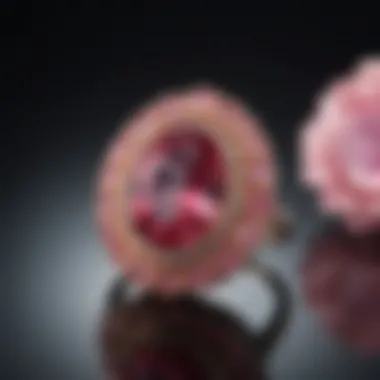
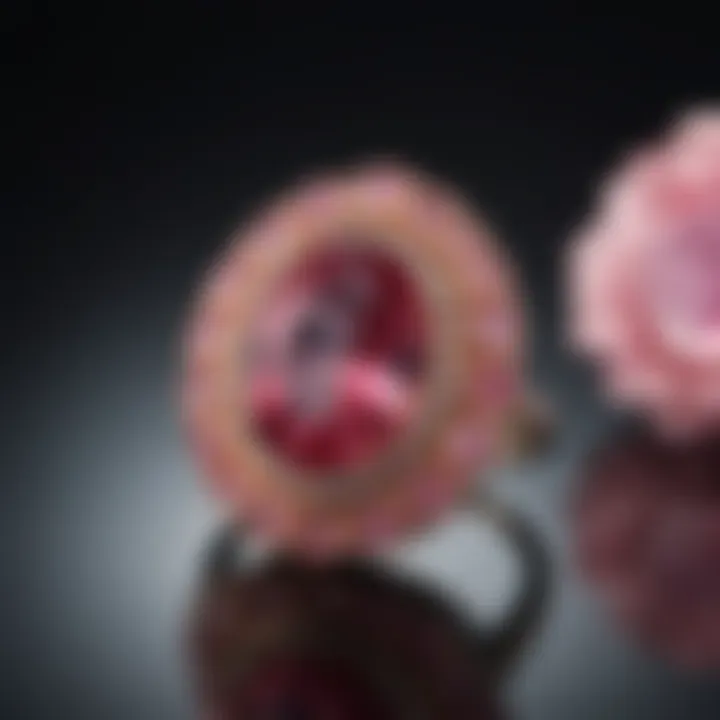
Identifying Authenticity
When collecting minerals, particularly pink varieties that can sometimes resemble one another, identifying authenticity is critical. Here are steps to ensure what you have in hand is genuine:
- Check for Certifications: Before purchasing a mineral, ask for any accompanying certificates that confirm authenticity. Many reputable dealers provide documentation that vouches for the mineral’s legitimacy.
- Examine Physical Properties: Understanding the physical properties such as cleavage, hardness, and specific gravity can aid in distinguishing genuine pink minerals from imitations. For instance, rose quartz has a notable translucency that synthetic options often lack.
- Use Simple Testing Methods: Conduct basic tests, like the scratch test to assess hardness. A true mineral should resist scratching from materials of a lower hardness level.
- Seek Expert Opinions: When in doubt, consult with a gemologist or a local mineralogy club. Their expertise can provide clarity and assurance in your collecting journey.
Acquiring pink minerals can be both thrilling and intellectually stimulating, offering insights not only into the earth's history but also about market dynamics and ethical considerations in collecting. By following these tips for new collectors and ensuring the authenticity of your specimens, you can build a collection that stands the test of time.
Emerging Trends in Pink Minerals
Exploring the realm of pink minerals isn't just an academic endeavor; it's a deep dive into a vibrant and changing marketplace. As collectors and enthusiasts become increasingly discerning, the trends in this niche segment evolve, reflecting greater interests in sustainability, rarity, and unique aesthetic qualities. In this section, we will unpack these developments that shape the future of pink minerals and why they matter.
Changing Preferences in the Market
The market for pink minerals has been shifting significantly. Once dominated by standard specimens, there’s now a vibrant pursuit for rarer and more visually striking varieties. Factors influencing these preferences include:
- Sustainability: Collectors today are more aware of environmental impacts. Materials sourced responsibly are gaining favor, compelling miners and suppliers to adopt ethical mining practices. For instance, pink tourmaline sourced from fair-trade operations is now highly sought after.
- Aesthetic Appeal: It's no longer just about having a piece in a collection. The focus has expanded to unique color hues and patterns. Unearthed specimens with an extraordinary play of color, like a streaked rhodonite that showcases an intricate blend of pinks and blacks, command higher prices and more attention.
- Cultural Influences: The rise of social media has amplified the visibility of pink minerals, showcasing their beauty among wider audiences. Platforms like Instagram and Pinterest allow collectors to share unique finds and create trends around specific minerals. This visual culture drives demand for exceptional pieces.
"Each mineral tells a story. The rarer the story, the more appealing the piece becomes for collectors." – A renowned gemologist
Moreover, the concept of "investment-grade" minerals is taking hold. Collectors are now eyeing pink gemstones, such as pink sapphires or exquisite pink diamonds, not just for their beauty but as a secure long-term investment. The rarity and appreciation of fine specimens in auctions reinforce this trend.
In summary, the preferences surrounding pink minerals are shaped by a confluence of ethical considerations, aesthetic appreciation, and the influence of culture and social media. These emerging trends suggest a future where the demand for unique, sustainably sourced pink minerals will likely continue to rise, hinting at a deeper appreciation for these geological marvels.
Future Research Directions
Research into pink minerals is an evolving field, revealing both the complexity and potential of these unique geological treasures. As we dive deeper into the future directions of this study, it's crucial to appreciate why this topic holds significance for both science and collectors alike.
Understanding the unexplored properties of pink minerals not only broadens our scientific knowledge but also enhances the practical applications these minerals might offer. Collectors and geologists alike stand to gain immeasurably from new findings, informing everything from collection strategies to investment decisions.
By identifying previously overlooked properties, researchers can enhance both the value and the understanding of these pink minerals. This potential for discovery is particularly promising in areas such as gemology, where new characteristics may lead to novel techniques for stone treatment or enhancement.
Moreover, focusing on emerging applications can open doors to fields outside of traditional mineral use. For example, exploring how specific structural properties of pink minerals could lead to innovations in technology or sustainable materials could redefine how the mineral world interacts with industry.
To illustrate, consider the ongoing investigations into how certain pink minerals might possess unique piezoelectric properties. If proven, these could lead to applications in electronics or renewable energy, areas where mineral applications have remained largely untapped.
Unexplored Properties and Applications
As researchers push the envelope, various unexplored properties surface.
- Chemical Properties: Compounds like tourmaline are known for a diverse range of electrical properties. Understanding how these minerals react under different conditions can offer insight into their potential uses.
- Physical Characteristics: Beyond color, variations in texture or inclusions could reveal new identifiers essential for both collectors and commercial use.
- Cultural Relevance: Additionally, exploring how different cultures utilize pink minerals can provide a broader perspective on their significance across societies.
"The future isn't something we enter; the future is something we create."
To keep pace with evolving interests in geology and gemology, researchers must foster collaborative efforts across borders. Engaging in international studies can refine our understanding of geographic distribution, ultimately leading to better conservation efforts and knowledge sharing.
Overall, future research directions in this area promise to pave the way for breakthroughs that not only cater to collectors but also contribute meaningfully to scientific advancement. The excitement lies in what remains to be discovered beneath the surface of these pink beauties.
Closure
In wrapping up our exploration of pink minerals, we encounter a rich tapestry of geological marvels that not only captivate the eye but also reveal a plethora of insights about our planet. This discussion has traversed the intricacies of formation processes, variances in chemical composition, and the striking variety of notable pink minerals. Each of these elements represents just the tip of the iceberg when it comes to understanding their significance in both natural settings and human applications.
Recap of Key Points
Reflecting on our key discussions, several points stick out:
- Geological Heritage: Pink minerals are formed through complex geological processes that involve both time and environmental conditions. Each mineral tells a story of its journey through the Earth's crust.
- Identifying Features: Knowing how to identify distinct pink minerals like rose quartz or pink tourmaline equips collectors with the skills needed to distinguish genuine specimens from imitations. This helps ensure investment in high-quality pieces.
- Cultural Significance: Beyond geology, these minerals carry deep cultural meanings, often associated with love and protection. Their symbolic nature enriches their value, making them cherished in various traditions and practices.
- Environmental Awareness: Understanding where these minerals are sourced highlights the need for sustainable collection practices. Collectors have a role to play in advocating for responsible mining and protecting ecosystems.
- Future Research: There remains a wealth of unexplored properties and applications for pink minerals, suggesting that both academic and hobbyist inquiry can lead to new discoveries.
In summary, the relevance of pink minerals extends far beyond aesthetics; they combine art, science, and history in an alluring package. Embracing this knowledge enhances our appreciation, drives ethical practices in collecting, and stimulates ongoing curiosity in geology and beyond. As we continue to learn and share, the world of pink minerals awaits to unfold further mysteries.
Citations and Further Reading Suggestions
To facilitate further inquiry, the following citations and suggestions are invaluable:
- Wikipedia: Offers an overview of relevant geologies and classifications for pink minerals.
Visit Wikipedia - Britannica: Provides in-depth articles on specific minerals and their geological significance.
Visit Britannica - Reddit: Ideal for discussions among collectors and enthusiasts where many share their experiences and advice.
Visit Reddit - Facebook: Groups dedicated to mineral collecting can provide real-time information and community support.
Visit Facebook
Utilize these references to delve deeper into the world of pink minerals, enhancing your knowledge and appreciation of these unique geological treasures.
Appendix
The appendix in this exploration of pink minerals serves a vital role. While the main body of the article provides thorough insights into various aspects of pink minerals, the appendix enriches reader understanding by offering additional resources, clarification of terms, and deeper dives into certain concepts that may have piqued interest during the reading.
Importance of the Appendix
Including an appendix allows for a systematic collection of vital information and references. It is an effective way to index specific terms that are central to the discussion around pink minerals but may not be deeply elaborated on in the main sections. This can be particularly beneficial for readers who are rock and fossil collectors, as it provides them with easy access to definitions and nuances associated with various terminology they might encounter.
Specific Elements
One of the key aspects of the appendix is the glossary of terms related to pink minerals. This glossary acts as a dictionary for enthusiasts, enabling them to decode technical jargon or regional terminologies that might be obscure. For instance, words such as "manganese" often pop up when discussing the color variations in pink minerals like Rhodonite.
Benefits of an Appendix
- Reference Tool: Acts as an easy reference point for terms and definitions.
- Enhances Learning: Assists readers in grasping complex concepts without overwhelming them in the main segments.
- Encourages Deeper Study: Promotes further exploration of pink minerals, yielding greater appreciation and knowledge.
Consideration About the Appendix
When constructing the appendix, it’s crucial to tailor it to the intended audience. For those immersed in geological or gemological studies, contents should be concise yet informative, enabling a variety of users—ranging from seasoned professionals to passionate novices—to find value. A well-structured appendix not only functions as a tool for quick reference but also spurs curiosity, inspiring readers to further their journeys in the fascinating world of pink minerals.
In essence, the appendix can transform the reading experience from mere consumption of information to active engagement with the subject matter.



